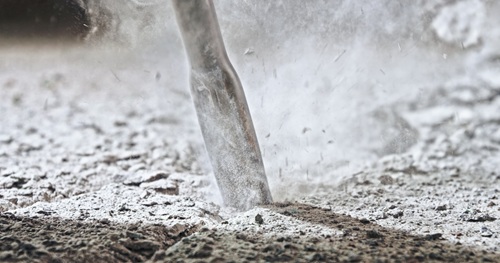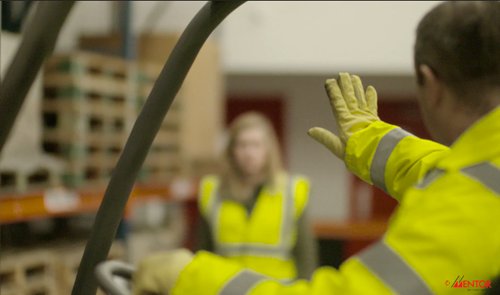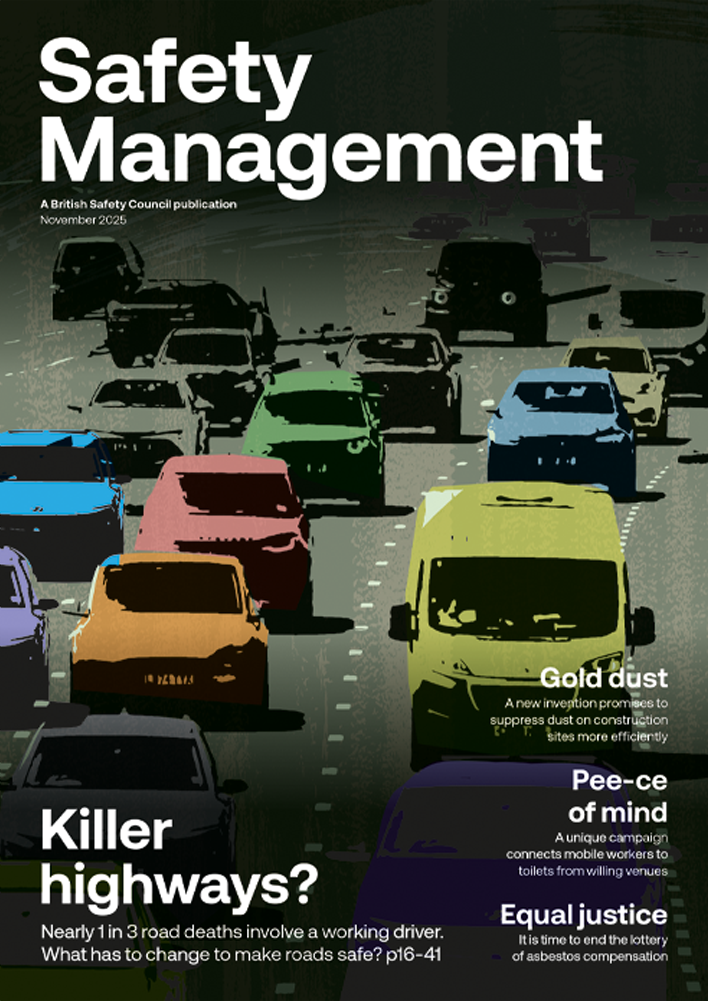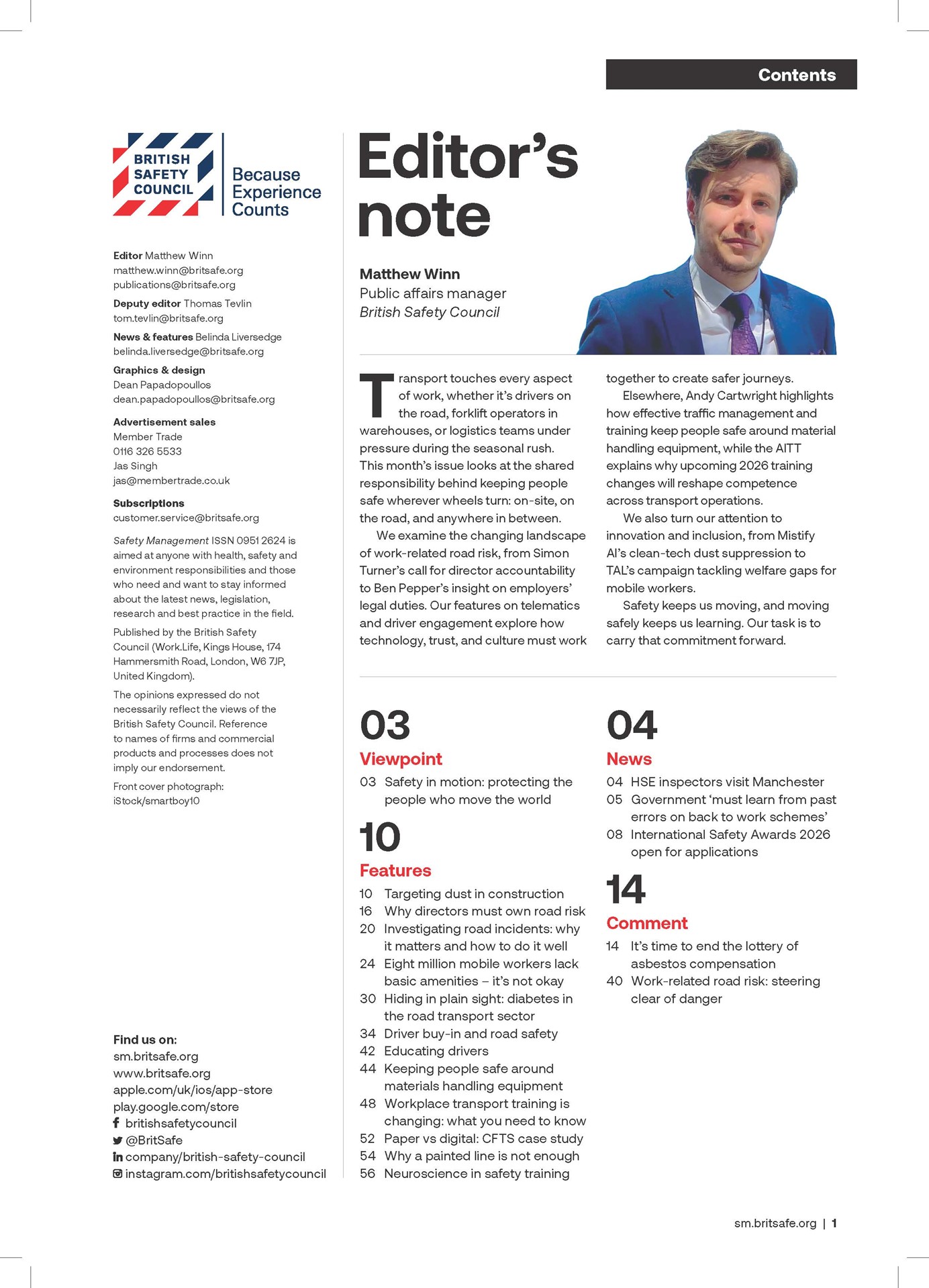It seems like America today is rarely out of the news, particularly since President Trump won his second term. Our ‘special relationship’ with America has continued, with the country a strong pipeline for inspiration, products and trends.
Features
Stars, stripes and safety
When it comes to legislating for better health and safety at work, America also got there before we did, enacting the Occupational Safety and Health Act (OSH) in 1970 to our 1974. America was the first to popularise mental health and therapy. Yet, what do we know of health and safety in America really? How is it ‘done’ there? And what does this tell us about the American character and values? Are there advantages and challenges to the US system for health and safety? As this system itself comes under threat by an administration seeking to curb its powers, it’s timely and important to explore.
A prescriptive approach
Workplace safety in America is governed by the OSH Act of 1970. The Act is organised into four distinct elements; the most notable are those relating to construction and general-industry workplaces. It is further separated into several “parts” and “sub-parts”, each covering a particular compliance topic, such as machine guarding, excavations and hazardous chemicals.
 Since the start of 2025, the administration under President Trump has significantly reduced funding for research institutions, including in safety. Photograph: iStock
Since the start of 2025, the administration under President Trump has significantly reduced funding for research institutions, including in safety. Photograph: iStock
James Pomeroy, a safety leader writing in 2010 for the former publication Safety Health Professional (SHP) Online, explains: “Generally, the technical requirements of the OSH Act – or standards, as they are often called – are very prescriptive and tend to focus on basic mechanical and chemical hazards, with little emphasis on systems, process and leadership. Consequently, the Act is rather similar in style to the old UK Factories Act 1961.”
Good or bad?
Critics have argued that the Act’s prescriptive approach can be disempowering. Writing for Safeguard magazine’s February 2021 issue, Ron Gantt a director at a US consultancy, says: “Ironically for a country priding itself on innovation, the H&S approach.. is often traditional, top-down, accountability-based, and compliance-orientated. Much of h&s has significant overlap with liability risk management, rather than helping people to do risky work safely.”
But others we spoke to have a more balanced view, arguing that the clarity of the law is helpful. Xavier Alcaraz, global practice director for Health, Safety, and Wellbeing at BSI Consulting in the US said: “It is true that many of health and safety regulations in the US are prescriptive. Legislators.. require that regulations be clearly defined so that the business community can more easily accept, adopt, and comply with them.”
Nick Farkas, Global Director Consultancy & Advisory Services at Shirley Parsons, says that we may approach safety in different ways, but can both arrive at the same goal: “US firms can focus more on compliance due to the country’s culture of litigation and the prescriptive nature of its legislation. In contrast, in my experience, UK companies have more of an onus on organisational safety culture.”
“No one way is necessarily better than the other, and we certainly see many similarities in how US and UK firms approach workplace safety and health. Many of the US companies I talk to do very much see the wider benefits of health and safety, beyond complying with regulations.”
 President Nixon signing the Occupational Safety and Health Act of 1970. Photograph: Wikimedia
President Nixon signing the Occupational Safety and Health Act of 1970. Photograph: Wikimedia
A look at OSHA
OHS regulations are developed and, largely, regulated by the federal government agency, the Occupational Health and Safety Administration (OSHA). Each state can choose to develop and enforce its own programme, but these must be at least equal, or equivalent to the federal requirements.
Like HSE in the UK, OSHA inspects to ensure compliance with these standards. It also provides training and resources to help employers comply with them.
One major difference between the role of OSHA in the UK and HSE in the US is the system allows for companies to dispute charges.
OSHA issues ‘citations’ (a type of legal summons widely used in the US for summary offences) following discovery of a breach and companies can appeal. Yet OSHA argues that this competitive system drives better performance. When Amazon reached a settlement with OSHA in December 2024 over ergonomic failures – ten trials were due to be heard in respect of “serious lower back and MSK disorders” – it did so on the proviso that changes would be made.
These included redesigning workstations, job rotations and ergonomic flooring. “Corporate-wide settlements can be a critical tool to protect workers from health and safety violations because they can incentivize companies to solve underlying problems,” said Seema Nanda, the Solicitor of Labor who worked on the case.
‘A more emotional approach’?
This year, OSHA marked World Safety Day on 28 April – a day devoted to remembering those who have died at work – with two films – one simply a ‘scroll of fallen names’; the names of people who had died through work, the other featuring interviews with family who had lost their loved ones through a workplace accident. Both were very moving and as decisions to mark annual fatalities, they could not be more different as approaches to ours in the UK where we simply issue the fatality data in PDF reports.
 OSHA marked World Safety Day on 28 April with two very moving videos to honour those killed at work. Photograph: iStock
OSHA marked World Safety Day on 28 April with two very moving videos to honour those killed at work. Photograph: iStock
Storytelling is important to safety professionals in the US as a tool for learning, says Xavier: “Real stories and testimonials tend to be more impactful to the average American than data or regulatory citations. Safety trainers often include videos or share their own accounts of injuries and fatalities as part of the curriculum, reminding workers that these incidents could happen to anyone. These stories help connect the “what” we need to do with the “why” it’s so important.”
There’s also a sense of work as ‘service’ in America, an idea that we wouldn’t necessarily recognise in the UK. “It’s not uncommon for those who lost their lives at work to be described as ‘fallen heroes’. It’s about that strong sense of service and yes, perhaps Americans have a more emotional approach,” says Nick Farkas adding that Memorial Day in May, which commemorates deceased service men and women, has much in common with Workers’ Memorial Day.
Politics
Since the start of 2025, the administration under President Trump has significantly reduced funding for research institutions — aiming, it says, to eliminate waste and bias in government-funded research. US government spending on health research reached a 10-year low last month.
Thousands of federal workers have also been laid off – though some decisions have been partially rescinded. CNN, which is tracking what it calls an ‘evolving situation’ says at least 128,709 workers have been laid off or targeted for layoffs from federal agencies, as of 26 June. At the Centres for Disease Control and Prevention (CDCP), about 12.7 per cent have been fired, according to the news organisation.
The National Institute for Occupational Safety and Health, or NIOSH, sits inside the CDCP, where 935 of the agency’s 1,100 workers, or 85 per cent, lost their jobs following a “reduction in force” order in April. Following pushback from labour unions and the public, only 328 employees were reinstated.
 The National Institute for Occupational Safety and Health, or NIOSH, sits inside the CDCP, where 85 per cent lost their jobs following a “reduction in force” order in April. Photograph: iStock
The National Institute for Occupational Safety and Health, or NIOSH, sits inside the CDCP, where 85 per cent lost their jobs following a “reduction in force” order in April. Photograph: iStock
A Bill to abolish the Occupational Safety and Health Administration (OSHA) has also been underway since March. The Bill, titled the “Nullify Occupational Safety and Health Administration Act” or “NOSHA Act”, aims to repeal the OSHA Act of 1970, effectively dismantling the agency. Congressman Andy Biggs, who introduced the Bill, claims this will help to “jump start” the mission of Trump’s Department of Government Efficiency (DOGE) initiative as it seeks to reduce the size of government.
These changes are among the most drastic proposed in the country’s history to safety. Yet, there’s a tradition and precedent for politics to get more involved in the safety systems and laws in America that we wouldn’t recognise in the UK, where government is largely content for things to stay as they are.
James Pomeroy explains: “The development and regulation of safety is subject to much greater political influence than in the UK, with the creation and enforcement of regulations in the US often being forced in contrasting directions, depending on the political orientation of the administration.”
In addition, special-interest groups take a far greater role in the development of OHS legislation. “This politicisation of safety is difficult to imagine in the UK where, for the past 30 years, there has been a broad consensus among political parties on regulating workplace safety,” he writes.
‘Critical pillar’
Still, the cuts to NIOSH have shocked many. “While most Americans are in favour of cost savings and reducing waste, fraud, and abuse in government, the proposed cuts to NIOSH were very alarming to the HSE community,” says Xavier Alcaraz. “NIOSH is a critical pillar in implementing cutting-edge research on occupational health and safety, and it plays an instrumental role in providing data. Cuts to workplace safety and health would be a massively retrograde step.”
NIOSH is also a major funder of workplace safety training and research and this past month, Reuters reported how high-risk industries like fishing, farming and logging stand to lose out most. Seven training centers servicing these sectors are in process of shutting down. J. Glenn Morris, director of the Southeastern Coastal Center for Agricultural Health and Safety, told the news agency: “We’re shutting down the direct education to the workers, we’re shutting down the research.”
Mental health – the first?
The US was first to break the taboo around mental health in society, with Americans normalising the idea of therapy. When it comes to workplace health, are they further along the journey than us in the UK? What are the challenges that differ to ours when it comes to mental health at work?
Professor Sir Cary Cooper, an American-born British psychologist, says that the US invented the EAP – employer assistance programme – and to this day, he believes that Americans have been better at treating mental health as a “real health hazard to individuals – we still haven’t invested the money in it.”
 Cary Cooper: "People talking about stress, depression and anxiety started much earlier in America."
Cary Cooper: "People talking about stress, depression and anxiety started much earlier in America."
NIOSH were the first governmental safety body in the world that did research on stress at work back in the 1980s. Cooper was there at the time, working as an advisor. “People talking about stress, depression and anxiety started much earlier in America. They were [then] very good at showing ‘here’s what the research shows’ on stress. But the [guidance produced by the British soon after] – the HSE – had stronger teeth.”
The UK guidance makes it clear, he says, that employers have a duty of care to look after their workers’ health and wellbeing – and enforcement action by HSE has been taken in this country. For example, improvement orders for hospitals, particularly those related to staff stress, to address issues like understaffing, toxic cultures and high workloads. “HSE also developed tools for organisations to use free to do stress audits of companies. Nowhere in the States do they do that,” says Cooper.
Nearly one in five US adults live with a mental illness, while workplace stress has been reported to cause 120,000 deaths in the US each year, according to OSHA. Statistics like these show that there are still huge mental health problems affecting workers in America, however seriously mental health may be taken as a health hazard as Cooper notes.
Xavier Alcaraz: “I believe we still have a long way to go to normalise mental health in the US, both in the workplace and in society at large. Poor mental health has long been viewed as a weakness in most business cultures. Substance abuse can exacerbate these issues, and several industries, such as construction and healthcare, have been particularly hard-hit, with poor mental health among workers contributing to increased suicide rates.”
America is a huge country – safety is a big topic. But we’ve had a small glimpse at America’s complex relationship to safety. On one hand, favouring laws and rules under a prescriptive OSHA. On the other hand, the independent and risk-taking spirit always nipping at the heels of the system with political parties arguing for less interference on business. America has been an influence on the UK, especially in the field of mental health – but neither country can claim to have solved the problems.
FEATURES

Targeting dust in construction
By Belinda Liversedge on 30 October 2025
Rohan Jindal was cycling to college in Dehli where he was studying engineering, when he had to stop. Not because of the hot sun beating down, but because he couldn’t breathe. And although asthmatic, that wasn’t the trigger. Looking all around he saw construction sites emitting large clouds of dust. This was his ‘a ha’ moment. “What,” he asked himself “do they do in construction to supress the dust?”

Paper vs digital – how CFTS is revolutionising work equipment inspections for members
By Rob Fisher, CFTS on 30 October 2025
A new mobile app makes it easier for CFTS-accredited businesses to manage the delivery of Thorough Examinations of customers’ work equipment, but it also benefits the customer through automated reminders about the safety of their machine and the results of the examinations.

Keeping people safe around material handling equipment at peak times
By Andy Cartwright, Mentor FLT Training on 30 October 2025
For many businesses, the Christmas and New Year period sees increased use of equipment like forklifts as customer demand, sales and goods handling surge, so it’s essential that measures like adequate segregation of people and machines are in place to keep everyone safe.



